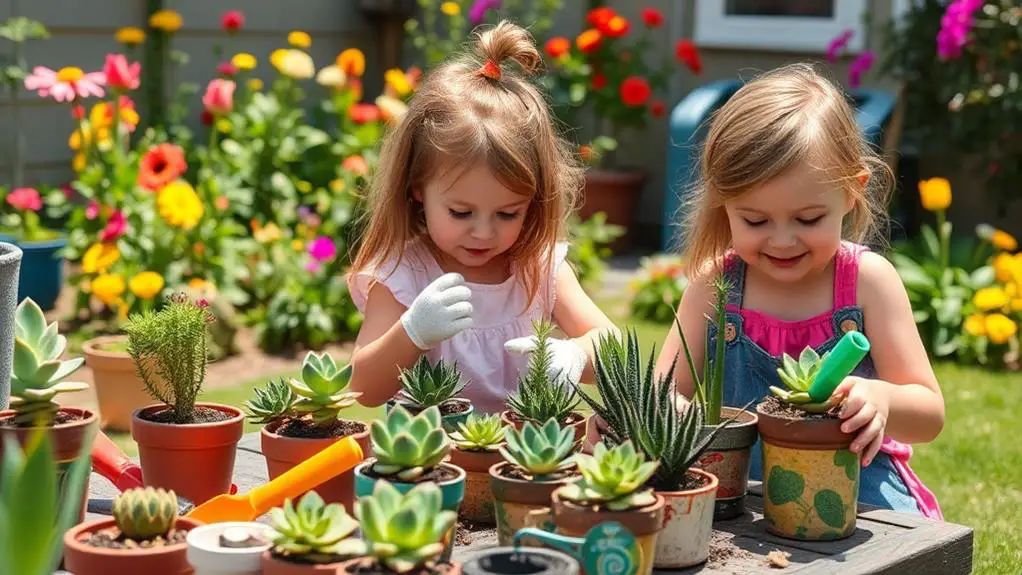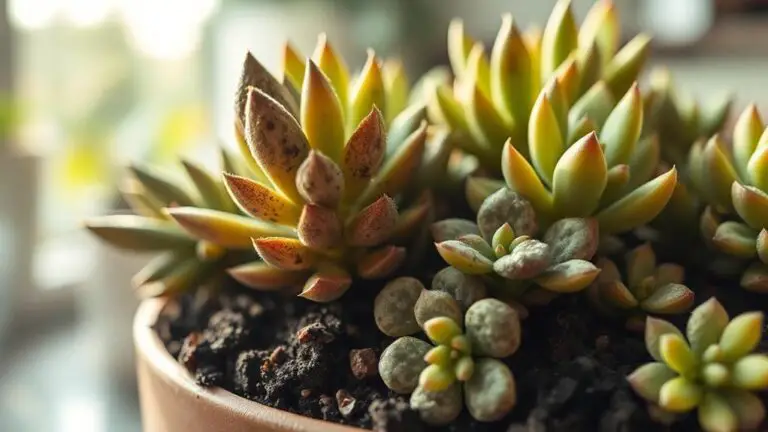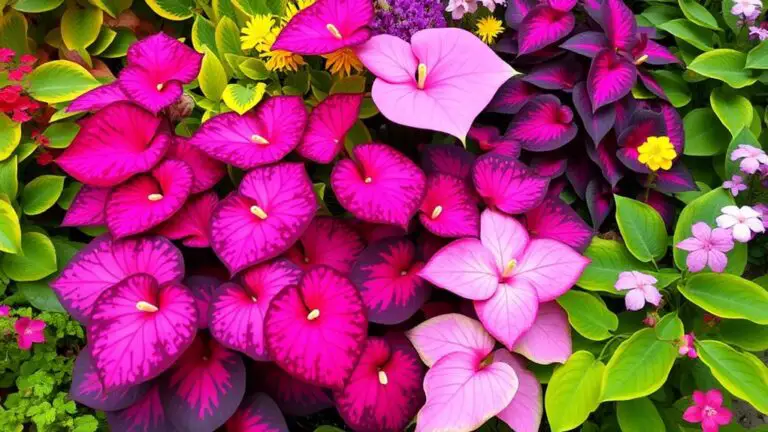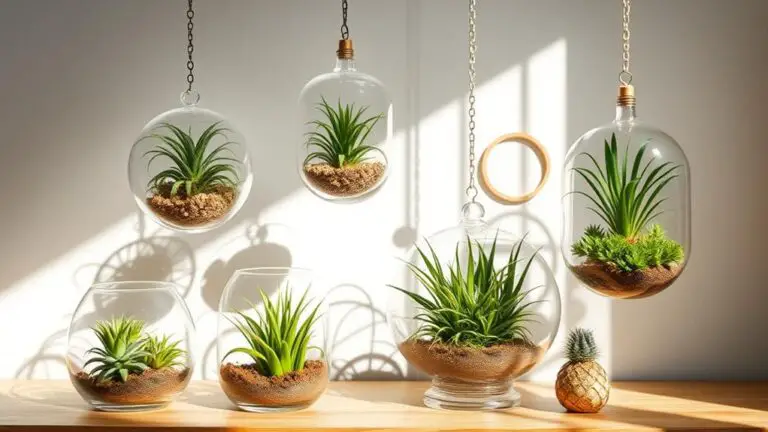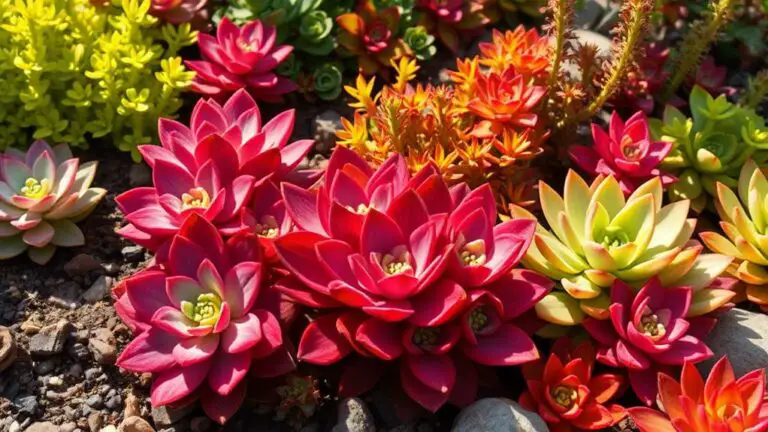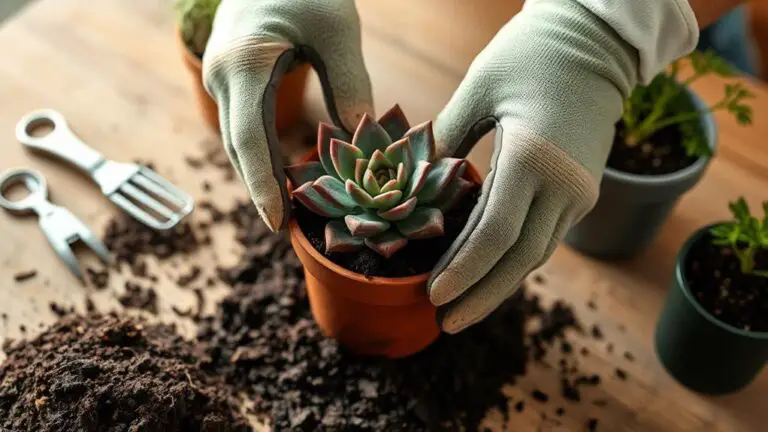7 Fun Succulent Activities for Kids
If you're looking for creative ways to engage kids in gardening, succulents offer a perfect blend of fun and education. From decorating colorful pots to designing intricate terrariums, there's no shortage of ways to spark their curiosity. You'll find that propagation projects and using recycled containers not only teach sustainability but also foster creativity. Imagine the joy on their faces as they watch their succulent crafts come to life, transforming simple materials into beautiful art. Curious about how to get started and keep the excitement going? Let's explore the first steps together.
Understanding Succulent Basics

Understanding succulent basics is a great starting point for kids interested in gardening. Succulents are unique plants that store water in their leaves, stems, or roots. This ability helps them thrive in dry environments, making them perfect for young gardeners.
With over 60 different families of succulents worldwide, you can explore a variety of shapes, colors, and sizes, which is an exciting way to learn about plant diversity and ecology.
Succulent care is easy and rewarding. These plants need plenty of sunlight, so place them where they can soak up the sun. They also require well-draining soil to prevent root rot.
Watering should be minimal; succulents prefer their soil to dry out completely between waterings. This low-maintenance routine makes succulents ideal plants for kids.
Adding succulents to your home can purify the air, boost your mood, and reduce stress. Plus, taking care of a succulent garden teaches responsibility and patience, helping you understand how plants grow.
As you nurture your succulents, you'll develop a deeper connection with nature. So start your succulent journey today and enjoy the many benefits these fascinating plants have to offer!
Planting and Decorating Pots

Now, let's get hands-on with planting your succulents and decorating the pots.
Choose a pot that you love and make sure it has drainage holes to keep your plant healthy.
Then, get creative by painting the pot with acrylic paint and adding fun decorations like small rocks or sand to make it uniquely yours.
Choosing Pot Designs
Why not make the pot as unique as the plant? When choosing pot designs, remember that a container with drainage is essential to prevent root rot, especially for outdoor succulents.
If you're using indoor pots without drainage, be cautious with watering. There are many creative options for pot designs that can make your succulent garden truly special.
Repurposing items like teacups, old shoes, or souffle dishes can add a whimsical touch to your arrangements. Not only do these choices look fun, but they also encourage recycling!
When selecting pots, think about how they'll complement the color and shape of your succulents. Vibrant, colorful pots can really make green or gray succulents pop.
Make sure the pots are the right size for your plants. Larger succulents need more space for their roots, while smaller ones can thrive in more compact containers. This helps the plants grow strong and healthy.
Choosing pot designs that allow for personalization, like pots you can decorate with natural materials such as twine and stones, makes the activity even more engaging for kids.
Encourage their creativity with these fun and practical options, and you'll both enjoy the planting process.
Decorating With Paint
Painting pots can be a delightful activity that lets kids express their creativity while personalizing their succulent containers. Start by choosing terracotta pots, which are ideal for decorating with paint because they hold colors well and provide a great canvas for imaginative designs.
First, make sure to clean the pots with soap and water. This will remove any dust or residue, helping the paint stick better and ensuring a smoother finish.
Once the pots are clean and dry, let your kids pick out some acrylic paint. Acrylic is perfect because it dries quickly and adheres well to terracotta.
Encourage your children to come up with themes for their pots. They might enjoy painting animals, nature scenes, or even abstract patterns. This not only makes the activity fun but also helps them engage more deeply with their succulent plants.
After the painting is done, allow the pots to dry completely. To protect their designs from water damage, seal the pots with a clear waterproof varnish. This step is essential to keep their artwork looking fresh and vibrant, even when watering the succulents.
Designing Terrariums

Designing terrariums is a fantastic activity for kids, combining creativity with a hands-on learning experience about nature. Kids love succulent-related activities, especially when it involves creating their own terrarium. You'll start by choosing a clear glass container to allow visibility, which lets children observe the growth and interactions within their miniature ecosystem.
Begin by layering materials:
| Layer | Purpose | Example Materials |
|---|---|---|
| Base Layer | Filtration | Activated charcoal |
| Second Layer | Growth medium | Potting soil |
| Top Layer | Aesthetics | Decorative stones |
| Plants | Biodiversity | Various succulents |
| Decor | Personalization | Small figurines, rocks |
First, place activated charcoal at the bottom for filtration. The next layer is potting soil, which provides nutrients for growth. Top it with decorative stones to enhance aesthetics. Kids can then choose a variety of succulent species to plant, adding different colors and shapes to teach them about biodiversity.
Encourage kids to personalize their terrarium with small figurines or unique rocks. This makes each project a reflection of their personality. Maintaining proper humidity is essential, so water sparingly since terrariums recycle moisture. This reduces the need for frequent watering. By following these steps, kids will create a beautiful and educational succulent-related project!
Creating Succulent Crafts
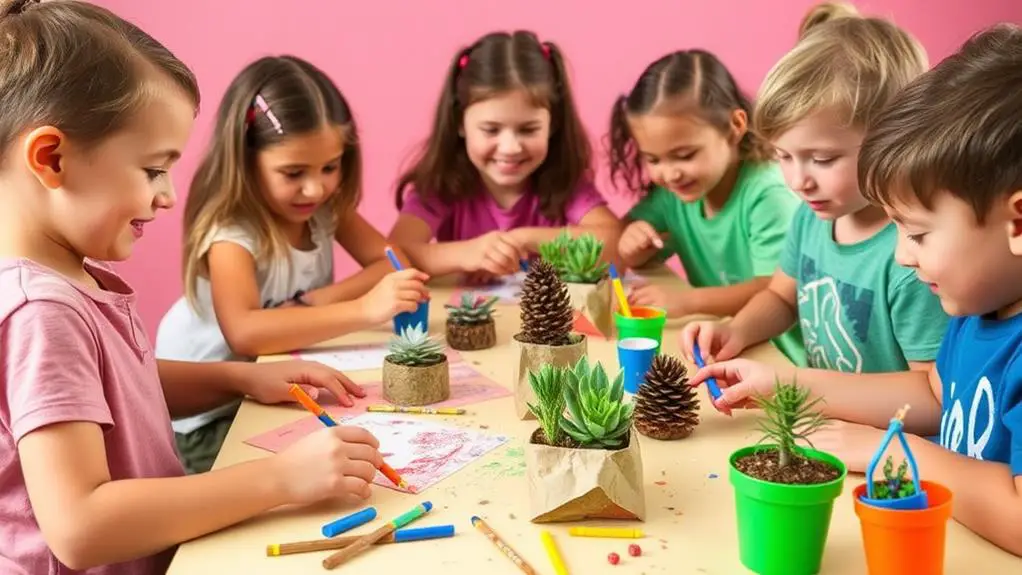
When it comes to creating succulent crafts, there's a world of fun and creativity waiting for kids. You can start by painting terracotta pots with vibrant colors and designs. This simple activity lets children express their creativity and personalize their plant displays. Each pot becomes a unique piece of art, perfect for showcasing their DIY succulents.
Another exciting project is designing DIY terrariums. Begin by layering activated charcoal, potting soil, and decorative stones. This hands-on experience teaches kids about plant ecosystems and the importance of each layer. Make sure to keep the soil in place to provide a stable environment for the succulents.
Crafting mini succulent gardens using unique containers like toy trucks or second-hand items is another great idea. This activity not only fosters imaginative play but also encourages recycling and creative reuse. It's amazing to see how everyday objects can be transformed into charming plant displays.
For a non-traditional approach, children can make faux succulents using Sculpey oven-bake clay. This enhances their crafting skills while introducing them to different succulent shapes and colors.
Engaging in succulent crafts promotes sensory exploration. Handling soil, plants, and decorative materials deepens kids' connection with nature, making these activities both educational and enjoyable.
Propagation Projects

Explore the fascinating world of propagation projects, where children can watch the magic of plant growth unfold right before their eyes. It's an engaging way to introduce kids to the wonders of nature.
Start with succulents for kids, like jade plants or Echeveria, which are especially easy to propagate.
Begin with leaf cuttings. Gently remove a healthy leaf from the succulent. Let it callous over for a few days to prevent rot. Then, place it on well-draining soil. Over time, roots will start to grow, eventually sprouting new plants. It's a simple yet magical process that teaches patience and care.
Stem cuttings are another great propagation method. Cut a healthy stem from the plant and allow it to dry out for a day or two. Afterward, plant the stem in soil. New growth typically appears within a few weeks, providing visible progress for curious eyes.
Create a propagation station using small jars of water to hold the cuttings. This setup allows kids to observe root development closely. These projects foster responsibility as children tend to their cuttings.
Over time, they'll see firsthand how their efforts lead to new plant life.
Gardening With Recycled Containers
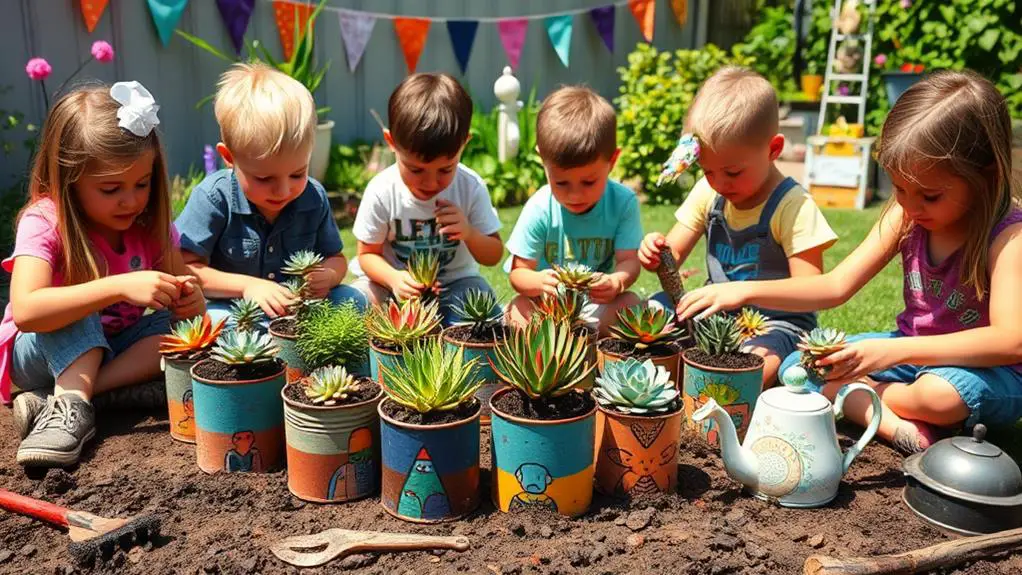
Gardening with recycled containers, like old teapots, shoes, or plastic bottles, is a fun way to be creative and eco-friendly.
Make sure to add holes for drainage, so your succulents stay healthy.
Personalizing these planters with colorful paint or decorations will make the project even more exciting, and it's a great chance to talk about reducing waste and caring for the environment.
Versatile Recycled Containers
Kids can immerse themselves in the fun of gardening by using versatile recycled containers like old teapots, plastic bottles, and even shoes to create unique planters for succulents. These recycled containers not only give new life to discarded items but also teach kids about sustainability and environmental responsibility.
When using recycled containers, make sure they've proper drainage to avoid root rot. You can add holes to the bottom or place marbles or stones at the base.
Decorating these planters is another way for kids to express their creativity. Let them use paint, fabric, or natural materials to personalize their succulent displays. This activity encourages them to think outside the box and fosters problem-solving skills as they find suitable containers for their plants.
Engaging in gardening with recycled containers helps children understand the importance of repurposing items. It's a fun and educational way to promote recycling and reduce waste.
Creative Planting Ideas
Building on the idea of using versatile recycled containers, let's now explore some creative planting ideas that can turn everyday objects into enchanting succulent displays. You can transform old teapots, shoes, or tin cans into unique planters. This not only repurposes materials creatively but also teaches kids about sustainability.
When selecting containers, make certain they have drainage holes. If they don't, add pebbles at the bottom to prevent water retention, which is essential for succulents. Using succulent soil is important to guarantee your plants thrive.
Kids can personalize their recycled planters by painting or decorating them. This fosters artistic expression and makes the gardening experience even more enjoyable. Plus, using recycled materials encourages children to think about waste reduction and the importance of reusing resources in gardening practices.
Here's a table with some creative ideas for recycled planters:
| Recycled Container | Decoration Ideas | Planting Tips |
|---|---|---|
| Old Teapot | Paint with bright colors | Guarantee good drainage with pebbles |
| Worn-out Shoe | Add fun stickers | Use succulent soil, water sparingly |
| Tin Can | Wrap in colorful paper | Drill drainage holes, add soil mix |
| Broken Toy | Use markers for designs | Choose small succulents, guarantee drainage |
Engaging in this activity promotes creativity and teaches children about the ecological impact of their choices, reinforcing environmental stewardship.
Learning Through Succulents
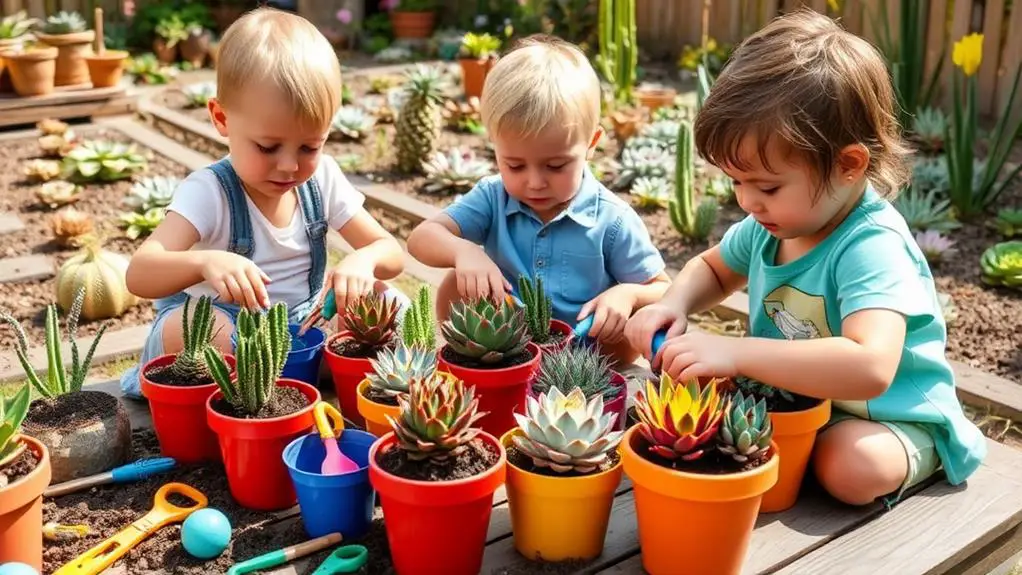
Engaging with succulent activities offers kids a fascinating way to learn about biology and ecology firsthand. By taking care of succulents, children can observe how these unique plants photosynthesize and contribute to their ecosystems. Succulents come in many different colors and shapes, making them fun and educational for young minds.
Creating mini gardens or terrariums lets kids explore plant anatomy and growth cycles in a hands-on way. They'll see how roots develop and leaves grow, gaining a deeper understanding of plant life. This activity teaches responsibility and patience as they monitor their plants' health over time.
Learning about different succulent species introduces children to the concept of biodiversity. They'll discover how each species fits into its environment and why conserving various plant habitats is essential. This knowledge fosters a sense of appreciation for the natural world.
Crafting DIY planters from recycled materials can be another exciting project. It not only sparks creativity but also teaches social responsibility and resource management. Kids learn that they can make a positive impact on the environment by reusing materials.
Frequently Asked Questions
Are Succulents Good for Kids?
Yes, succulents are great for kids! They're easy to care for and come in fascinating shapes and colors. By growing succulents, kids can learn responsibility, enhance their fine motor skills, and develop a love for nature.
What Are Some Facts About Succulents for Kids?
Succulents are amazing plants that store water in their leaves, stems, or roots. They come in many shapes and colors. They're easy to care for and can purify the air, making them great for any space.
How to Do a Succulent Bar?
To set up a succulent bar, provide various pots, soils, and decorative items. Let kids choose their materials, guide them on planting techniques, and encourage creativity. It's a fun, hands-on activity that fosters artistic expression.
How to Have a Succulent Planting Party?
Gather essential supplies like succulent kits, soil, pots, and kid-sized tools. Set up a sunny planting station with a plastic cover. Teach the kids about succulents, let them decorate pots, and provide a care guide.
Conclusion
You've got all the tools you need to plunge into fun succulent activities with kids! From decorating pots to designing terrariums, each project offers a chance to learn and grow together. Don't forget to try propagation and use recycled containers for eco-friendly gardening. These activities not only teach about plants but also spark creativity. So, gather your supplies and start your succulent adventure today. You're ready to create something amazing!

